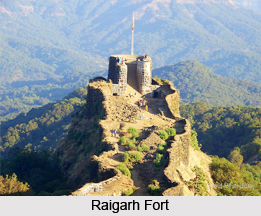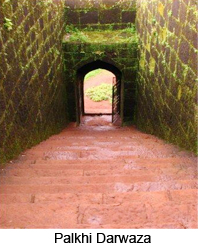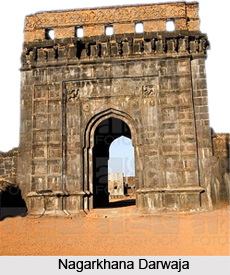 Raigarh or Royal Fort was the hill fort of Chatrapati Shivaji in Maharashtra where he was crowned and where he died as well. Known to the early Europeans as the Gibraltar of the East, Raigarh lies 32 miles to the South-West of Pune high up in the Western Ghats. It is one of the great strongholds of India, but it rose to importance between 1664 and 1680 when it was the capital during the last years of Shivaji`s reign.
Raigarh or Royal Fort was the hill fort of Chatrapati Shivaji in Maharashtra where he was crowned and where he died as well. Known to the early Europeans as the Gibraltar of the East, Raigarh lies 32 miles to the South-West of Pune high up in the Western Ghats. It is one of the great strongholds of India, but it rose to importance between 1664 and 1680 when it was the capital during the last years of Shivaji`s reign.
The fort of Raigarh, like all other hill forts, has witnessed a number of complex dynastic squabbles. It went on to be controlled by rulers from a number of different dynasties. Originally, in the twelfth century, it used to function as the seat of a family of petty Maratha chiefs, the Shirke-Palegar family, who paid tribute to the Vijayanagara princes and the Bahmani King. From 1479 to 1636 the fort passed to the Nizam Shahi rulers of Ahmednagar, who in turn ceded it to the Adil Shahi dynasty of Bijapur, but it was under Shivaji, who acquired the fort in 1648 from Chandrarao More, that it reached its heyday. In 1648 Shivaji was crowned prince at Raigarh, and he died here in 1680. After Shivaji it remained in the hands of Sambhaji. In 1690 Aurangzeb took control, but it reverted to the Marathas in 1735 AD and was surrendered to the British under Colonel Prother in 1818.
The fort is strategically situated on an irregular wedge-shaped mass of rock, detached from the main body of Sahyadri Mountains by a deep valley and inaccessible from three sides. To the west, south and east the hill is so sheer that there are no defensive walls. The 5.12 square kilometre hill top plateau of the fort has three main points- Bhavani in the East, Hirakani in the West and Takamak in the north. Only one pathway leads to Raigarh, in keeping with Shivaji`s strategy that the fort`s approach should be "easy for friends and impossible for foes".
 The ascent begins at Wadi, past some ruined granaries. Above the pathway on a spur is the Khublada bastion, access to which is along a narrow pathway and past a gate called the Nana Darwaza. Ruins flank the path up until there is a sharp turn. There is a motorable road leading to Chit Darwaza, which is about 24 kms from Pachad, a village at the base where there is found the samadhi of Jijabai, Shivaji`s mother. A long climb from Pachad leads to Mahadarwaza, which is flanked by two massive bastions and a high curtain wall. This was the main entrance to the fort. Over the gateway is the Shardula motif.
The ascent begins at Wadi, past some ruined granaries. Above the pathway on a spur is the Khublada bastion, access to which is along a narrow pathway and past a gate called the Nana Darwaza. Ruins flank the path up until there is a sharp turn. There is a motorable road leading to Chit Darwaza, which is about 24 kms from Pachad, a village at the base where there is found the samadhi of Jijabai, Shivaji`s mother. A long climb from Pachad leads to Mahadarwaza, which is flanked by two massive bastions and a high curtain wall. This was the main entrance to the fort. Over the gateway is the Shardula motif.
At this level a high curtain wall and broad fosse enclose the north-west frontage. 61 200 ft above are the remains of a second curtain wall; the same distance above this is a third line. The top of the plateau is covered with a number of ruins of buildings and reservoirs. The royal and public buildings arc reputed to have numbered over 300 stone houses and structures. Among the ruins lie the tomb of Madar, a Muslim saint, near to which is an oval reservoir. There is another, the Ganga Sagar, near the citadel, close to which are two two-storey towers with pointed windows done in Muslim style.
Behind these towers is the citadel or the Balekilla. It is entered by the Palkhi Darwaza. The King and his convoy used to enter the fort by means of the Palkhi Darwaza. To the right of the Palkhi Darwaza are three dark and deep chambers. It is believed that these were the erstwhile granaries. The main gate of the citadel is on the south wall. To the right of this are seven large apartments for the Royal ladies; on the left are guardrooms and the remains of the Darbar of Chatrapati Shivaji. The walls of the king`s court are still standing. On a low mound in the centre is the site of Shivaji`s throne.
The public Darbar of the King has a replica of the original throne which faces the main doorway called the Nagarkhana Darwaza. This enclosure was especially designed to enable one to hear from the doorway to the throne. There was a second entrance called the Mena Darwaza which was supposedly the private entrance of the royal ladies of the fort. This door leads to the queen`s quarters.
The main palace was constructed using wood of which only the bases of the pillars remain. The ruins of three watch towers can also be seen directly in front of the palace grounds overlooking the Ganga Sagar. There is also a view of the execution point, called Takmak Tok. It is a cliff from which the sentenced prisoners were thrown to their death. This area is now fenced off.
The Temple of Jagadiswara lies further North in a walled enclosure surrounded by a pond and the quarters of dancing girls. To the east is Shivaji`s chhatri, on an octagonal plinth. Also found here is the Samadhi of Shivaji and that of his favourite dog, Waghya.
There are ruins of many other buildings - houses, magazines and cisterns - as well as the old market place, with two rows of twenty-two shops. The shops in the market places were constructed in such a way that one could shop even while sitting atop a horse. To the north are the old elephant stables.
To reach the fort one has to climb approximately 1400-1450 steps. Today a ropeway also exists to aid reaching the top of the fort. The fort was plundered and destroyed by the British upon siege.



















